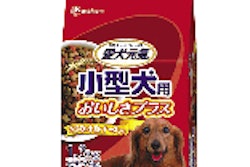
Petfood portion control is vital. Why? Because there is good evidence that portion sizes that are too large insidiously lead to obesity and its many negative consequences. Research spanning over 60 years has shown dietary restriction to be the only nutritional intervention that consistently extends the life span of animals.
A recent study of 48 Labrador Retrievers concluded that a 25% restriction in food intake increased median life span from 11.2 to 13 years (Kealy, et al., 2002, JAVMA 220:13151320). Compared with control dogs, food-restricted dogs weighed less and had a lower body fat content. In addition, the "aging markers" of food-restricted dogs were more positive: Lower serum triglycerides, insulin and glucose concentrations.
Portion control also delayed the onset of signs of chronic disease in these dogs. The chronic diseases diagnosed most commonly in the 48 Labradors were osteoarthritis (43 dogs); malignant mammary gland neoplasia (21 tumors in 17 dogs); benign neoplasia of the mammary glands (35 tumors in 12 dogs); recurring skin disease (19 dogs); and hepatic disease (11 dogs).
Ways you can help
Sean Delaney, DVM, DACVN is the principal consultant for Davis Veterinary Medical Consulting which specializes in nutritional consultancy for the petfood industry (www.dvmconsulting.com). He believes that there are ways petfood manufacturers can facilitate portion control, including:
Put a body condition scoring (BCS) chart with instructions on the package labeling.
Provide feeding guidelines that explain how to adjust food intake by focusing on the dog's BCS. Emphasize on product labeling that recommended feeding amounts are only starting points and will likely need to be adjusted.
Supply in-bag measuring cups and gradations on cans and pouches.
Recommend adding water to dry food and/or decrease the kilocalories per unit volume of dry food (increasing air content).
Provide caloric data on labels and supporting websites.
Recommend regular exercise and provide clear feeding procedures for treats, including the recommendation to decrease regular meal amounts.
Body condition scoring
The Body Condition System was developed at the Nestle Purina Pet Care Center and has been validated as documented in several publications. Start by figuring out where the pet falls on the body condition chart. In order to do this, conduct three checks of the pet:
Rib check: Place both thumbs on the pet's backbone and spread both hands across the rib cage. One should be able to feel the ribs. Actually feeling the pet is important, as the coat of many pets will make a visual check difficult.
Profile check: Examine the pet's profile; it's best if you are level with the pet. Look for the abdomen to be tucked up behind the rib cage.
Overhead check: Looking at the pet from overhead, one should see a waist behind the ribs. Most pets at a healthy weight have an hourglass figure.
Based on these three checks, determine the pet's body condition score. For dogs, use the following guide.
1.Ribs, lumbar vertebrae, pelvic bones and all bony prominences evident from a distance. No discernible body fat. Obvious loss of muscle mass.
2.Ribs palpable without excess fat covering. Waist observed behind ribs when viewed from above. Abdomen tucked up when viewed from side.
3.Massive fat deposits over thorax, spine and base of tail. Waist and abdominal tuck absent. Fat deposits on neck and limbs. Obvious abdominal distention.
Anywhere, anytime, by anyone
One way to make portion control easier is with a product called SmartPak. It is a service that provides pre-measured dog food along with medications and supplements. Customized packs are shipped directly to dog owners every 28 days. Becky Minard, founder of SmartPak, notes that the service costs about US$1.48 per day to feed a 20-pound dog. Popular additions to SmartPaks, that add cost, include fatty acid supplements, vitamin-mineral supplements and Cosequin (glucosamine chondroitin sulfate).
SmartPaks encourage dog owners to feed a consistent amount over a period of time. Minard points out that it is important for owners to know exactly what they are feeding before they can make appropriate modifications to the portion that their dog is getting. The company sends owners an E-mail every month before shipping the next order. By responding to the E-mail, owners can adjust the portion size up or down. At present, SmartPaks are available for dogs and soon will be for cats (www.smartpak.com).
Electronic portion control
Another way to assist in portion control is an electronic dry food dispenser. An example is the Le Bistro product from Petmate (www.Petmate.com). It can be programmed to dispense portions from ¼ cup to 2 cups at three selected times per day. The food hopper holds approximately four pounds of dry food and handles a range of dry food sizes, shapes & types, up to ¾ inch diameter. The cost is US$50-60.
True for people
In October 2004, the journal Obesity Research, published an article on the results of a 24-month obesity study in people. According to the lead researcher Everett Logue, PhD, the greatest weight loss in the study was related to portion control. "Although we saw similar patterns of weight loss related to reduced dietary fat consumption, increased fruit and vegetable consumption, increased physical activity and increased planned exercise, the target behavior that induced the greatest weight loss was portion control."
You must remember this
The most common cause of obesity in dogs is overfeeding coupled with inactivity. It is important for petfood manufacturers to provide clear feeding guidelines that encourage owners to adjust food intake by focusing on their dog's body condition score. The BCS system defines the ideal condition as one in which the dog's ribs are easily felt and the waist and tuck-up (the belly area between ribcage and rear end) are discernible.
It is true: An ounce of prevention is worth a pound of cure. Preventing excess weight gain is the best approach to weight control in dogs (and people). It is much more difficult to take the weight off once it has been gained. Portion control and regular exercise are the keys to the prevention and management of obesity.
















